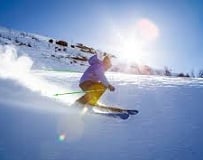The term ski derives from the French ski , in turn coming from the Norwegian language. This is the name given to an elongated skate that is used to slide on water or snow. By extension, the sport and recreational activity that is carried out on these boards is called skiing.
 For example: “In the last Winter Olympic Games, the European country won seven medals in skiing” , “Go get the skis, it started to snow and we can have some fun” , “My dream is to ski in the Alps” .
For example: “In the last Winter Olympic Games, the European country won seven medals in skiing” , “Go get the skis, it started to snow and we can have some fun” , “My dream is to ski in the Alps” .
The original skis were made of wood . Nowadays, different materials are usually combined, such as titanium , carbon fiber and others. The skis are wider at the tail and at the tip than in the central sector, where the binding is located: this is where the skier's boot is hooked. The person also uses canes to propel themselves and maintain balance.
As a discipline , skiing can be practiced recreationally or competitively. The most popular is skiing that is done on snow , generally in mountains with slopes prepared for this activity.
There are numerous benefits that are considered to come with practicing snow skiing. Specifically, among them some stand out such as toning the muscles of the body, releasing stress, improving the abdominal muscles and even strengthening the back, thus preventing the appearance of pain.
In the same way, it is also highlighted that it helps improve body coordination, the ability to concentrate, agility and even balance.
One of the best-known types of skiing is alpine skiing . In this case, the skier must descend a slope in the shortest time possible and respecting a route marked on the circuit.
Within alpine skiing we can highlight the existence of several specialties, among which are the following:
-The slalom, which is the most important and prestigious event held in the world cup.
-The descent, which is one of the tests that arouses the most interest in the circuits of the aforementioned championship. Among the most relevant declines are Wengen and Kitzbuehel.
-The combined, which is made up of a slalom test and another downhill test.
-The Super G, in which the skier will have to demonstrate not only his capacity for precision but also speed. And he will have to face not only a downhill test but also a giant slalom test, which is another of the specialties of alpine skiing.
-The parallel, which basically consists of the skier having to face two descents simultaneously that take place on a route that has the peculiarity of being shorter than that of a slalom.
Cross-country skiing , for its part, consists of covering a long distance, also in the shortest possible time, but without slopes: the athlete advances on undulating or flat terrain.
Another type of ski is ski touring . These are excursions that take place in areas that are not marked, which is why they are similar to mountaineering.
Water skiing , finally, takes place on water . A motor boat tows the skier, who must try not to lose balance to avoid sinking.
